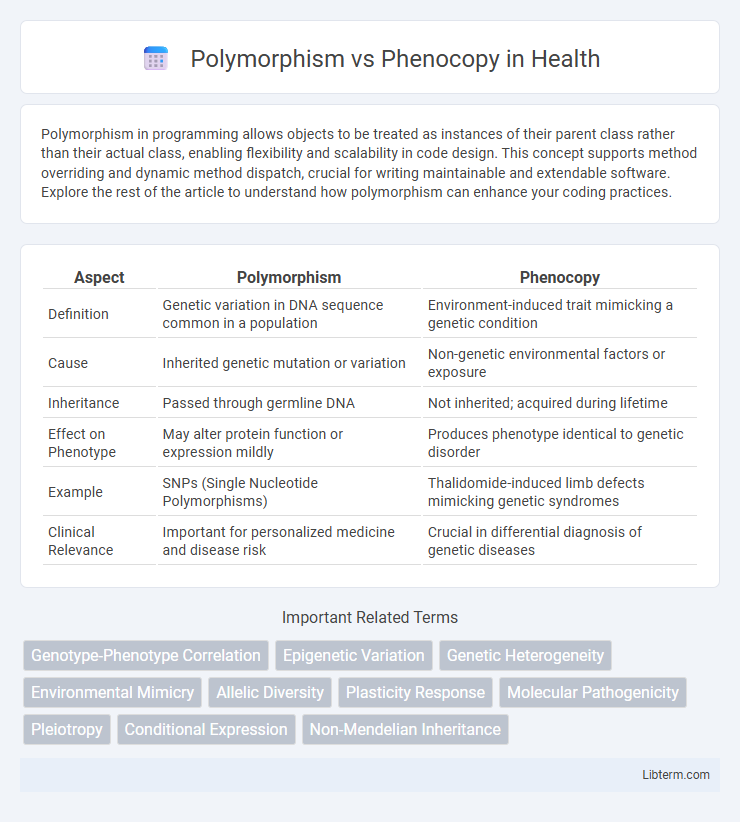Polymorphism in programming allows objects to be treated as instances of their parent class rather than their actual class, enabling flexibility and scalability in code design. This concept supports method overriding and dynamic method dispatch, crucial for writing maintainable and extendable software. Explore the rest of the article to understand how polymorphism can enhance your coding practices.
Table of Comparison
| Aspect | Polymorphism | Phenocopy |
|---|---|---|
| Definition | Genetic variation in DNA sequence common in a population | Environment-induced trait mimicking a genetic condition |
| Cause | Inherited genetic mutation or variation | Non-genetic environmental factors or exposure |
| Inheritance | Passed through germline DNA | Not inherited; acquired during lifetime |
| Effect on Phenotype | May alter protein function or expression mildly | Produces phenotype identical to genetic disorder |
| Example | SNPs (Single Nucleotide Polymorphisms) | Thalidomide-induced limb defects mimicking genetic syndromes |
| Clinical Relevance | Important for personalized medicine and disease risk | Crucial in differential diagnosis of genetic diseases |
Understanding Polymorphism: Definition and Examples
Polymorphism refers to the presence of two or more genetically determined variants or alleles in a population, where multiple phenotypes arise from different genotypes within the same species. Classic examples include the ABO blood group system in humans and the color variations in the peppered moth (Biston betularia). Polymorphism plays a critical role in maintaining genetic diversity and adaptability through natural selection.
What is a Phenocopy? Key Concepts Explained
A phenocopy describes a phenotype that mimics the effects of a genetic mutation but arises from environmental factors rather than changes in the DNA sequence. Unlike polymorphism, which involves genetic variations within a population that contribute to trait diversity, phenocopy results from external influences causing an organism to exhibit a trait typically associated with a specific genotype. Understanding phenocopies is crucial in genetics and medicine for accurately distinguishing between inherited mutations and environmentally induced traits.
Genetic vs Environmental: Core Differences
Polymorphism refers to the presence of multiple genetic variants within a population that result in distinct phenotypes, driven by inherited DNA sequence differences. Phenocopy, in contrast, describes environmental factors inducing a phenotype that resembles a genetic mutation but arises without underlying genetic changes. The core difference lies in polymorphism being genetically encoded variation, while phenocopy is an environmentally triggered mimicry of genetic traits.
Underlying Mechanisms of Polymorphism
Polymorphism arises from genetic variations within a population, where multiple alleles at a locus contribute to distinct phenotypes, often maintained by natural selection mechanisms such as balancing selection or frequency-dependent selection. These genetic differences result in stable, heritable traits that confer adaptive advantages under varying environmental pressures. In contrast, phenocopies are environmentally induced phenotypes mimicking genetic traits without underlying genomic alterations, highlighting the distinction between inherited polymorphisms and environmentally triggered phenocopies.
How Phenocopies Arise: Causes and Triggers
Phenocopies arise from environmental factors or external triggers that mimic the effects of genetic mutations without altering the DNA sequence. These causes include exposure to chemicals, infections, nutritional deficiencies, or physical agents that induce phenotypic changes similar to inherited traits. Understanding phenocopy mechanisms is critical for distinguishing between genetic polymorphisms and environmentally induced traits in genetic research.
Real-World Examples: Polymorphism vs Phenocopy
Polymorphism is illustrated by the ABO blood group system, where genetic variation leads to multiple alleles producing different blood types in humans. Phenocopy occurs when environmental factors mimic genetic traits, as seen in certain cases of thalidomide exposure causing limb deformities resembling inherited conditions. Understanding these examples highlights how polymorphism results from genetic diversity, while phenocopy arises from non-genetic influences producing similar phenotypes.
Evolutionary Significance and Adaptation
Polymorphism enhances evolutionary adaptation by maintaining multiple genetic variants within populations, promoting biodiversity and resilience in changing environments. Phenocopy involves environmentally induced traits that mimic genetic variations but do not contribute to heritable adaptation or evolutionary change. Understanding the distinction between genetically driven polymorphisms and environmentally induced phenocopies is crucial for interpreting adaptive strategies and evolutionary dynamics in natural populations.
Methods for Distinguishing Polymorphism from Phenocopy
Methods for distinguishing polymorphism from phenocopy primarily involve genetic analysis techniques such as DNA sequencing and genotyping to identify inherited genetic variations versus environmentally induced traits. Family pedigree analysis helps differentiate polymorphisms, which show consistent inheritance patterns, from phenocopies that arise sporadically without a genetic basis. Functional assays and environmental history assessments further clarify whether a phenotype results from genetic polymorphism or is a phenocopy caused by external factors.
Implications for Genetic Research and Medicine
Polymorphism represents naturally occurring genetic variations that contribute to phenotypic diversity and influence disease susceptibility, making it essential for personalized medicine and pharmacogenomics. Phenocopy, a phenotype mimicking a genetic trait caused by environmental factors rather than genetic mutations, challenges genetic diagnosis and complicates the identification of true hereditary conditions. Differentiating between polymorphisms and phenocopies is crucial for accurate genetic research, effective treatment strategies, and the development of precise diagnostic tools.
Summary: Key Takeaways on Polymorphism and Phenocopy
Polymorphism refers to the presence of multiple genetic variations within a population that contribute to phenotypic diversity, often influencing traits through inherited alleles. Phenocopy describes an environmentally induced phenotype that mimics a genetically determined trait without the genetic alteration being present. Understanding the distinction is crucial for genetic research and diagnosis, as polymorphisms reflect hereditary variation while phenocopies arise from external factors altering gene expression or development.
Polymorphism Infographic

 libterm.com
libterm.com